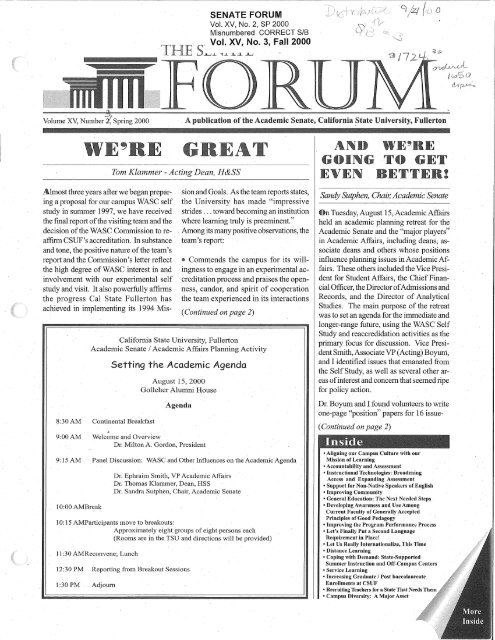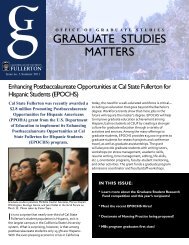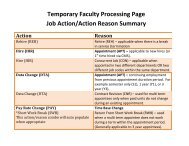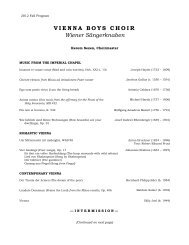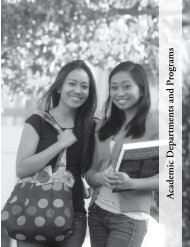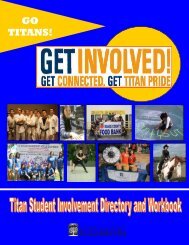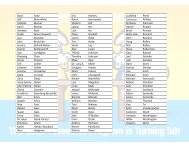Tom Klammer -Acting Dean, H &SS Setting the Academic Agenda Sandy ...
Tom Klammer -Acting Dean, H &SS Setting the Academic Agenda Sandy ...
Tom Klammer -Acting Dean, H &SS Setting the Academic Agenda Sandy ...
You also want an ePaper? Increase the reach of your titles
YUMPU automatically turns print PDFs into web optimized ePapers that Google loves.
Keith Boyum (<strong>Academic</strong> Affairs) & Lee Gilbert (Foreign Languages & Literature)<br />
Sure: <strong>the</strong> landscape is littered<br />
with largely unfulfilled efforts to<br />
"internationalize <strong>the</strong> curriculum."<br />
But who can doubt it? This<br />
·time, we simply must globalize.<br />
It's a commonplace that cheap transportation<br />
and a near-zero marginal cost of<br />
information via <strong>the</strong> internet have utterly<br />
changed our world. At <strong>the</strong> . same time,<br />
global warming, rising populations, immigration,<br />
<strong>the</strong> trans-national "sharing" of<br />
diseases, and <strong>the</strong> loss of rain forests stand<br />
alongside an alphabet soup of internationalism:<br />
EU; ASEAN; NAFTA; CNN;<br />
WTO (<strong>the</strong> one that provoked riots in Seattle);<br />
NATO (<strong>the</strong> one that went to war<br />
over Kosovo).<br />
Now considerthat 26% of <strong>the</strong> 1999 U.S.<br />
GDP was tied up in international trade.<br />
Some $250 billion of California's $1.2<br />
trillion GDP is dependent on international<br />
trade, with $100 billion of California exports<br />
a part of those numbers. And <strong>the</strong>re<br />
are more numbers. California's trade<br />
with Mexico in <strong>the</strong> first quarter of 2000<br />
exceeded <strong>the</strong> first quarter of 1999 by<br />
36.5%. California's trade with China has<br />
increased307% since 1990. (Where will<br />
it trend with <strong>the</strong> advent of permanent<br />
normal trade relations?) Meanwhile,<br />
RAND found ( 1994) " corporations eager<br />
for hires who have cross-cultural competence,<br />
but skeptical that foreign language<br />
or even study abroad programs can<br />
meet <strong>the</strong> need alone.<br />
Students have a sense of this. A June<br />
2000 telephone survey of CSUF undergraduates<br />
found 22% very interested and<br />
ano<strong>the</strong>r 41% somewhat interested in<br />
study abroad. They'd like lower costs<br />
(75%), and good fit with academic majors<br />
(73%) to facilitate <strong>the</strong> experience.<br />
Their preferred destinations are conventional:<br />
about 2/3 would have Europe in<br />
mind. .<br />
Given <strong>the</strong>se realities, it is more than selfevident<br />
that our programs for student<br />
learning and for faculty development<br />
must take on a global cast. International<br />
experience must be added both to student<br />
and to faculty lives. More than that: we<br />
must. develop global competence, with<br />
learning goals such as <strong>the</strong>se in-m.ind.<br />
Students will:<br />
Acquire <strong>the</strong> Conceptual Skills by which<br />
to understand peoples and processes that<br />
will be consequential for life that is<br />
inescapably global.<br />
Acquire Skills Required For:<br />
" Solving problems in multiple<br />
cultural milieus;<br />
• Communicating across cultural lines;<br />
" Communicating in a second language.<br />
Value:<br />
" Reflectiveness, self-reflectiveness:<br />
willingness to re-assess one's own<br />
views.<br />
" Differences in heritages and cultures.<br />
Some tactics to consider as we globalize<br />
our curricular and co-curricular programs:<br />
" Traditional student study abroad:<br />
one year; one semester<br />
• Shorter stays: some weeks during<br />
<strong>the</strong> summer, in January<br />
• International travel-study as a<br />
capstone to a course or degree<br />
.. International internships: AZ State<br />
facilitates student teaching in England ·<br />
" Develop a country focus:· Mexico<br />
is nearby<br />
• Partner with sister campuses, such<br />
as San Diego State<br />
" Make intentional programming use.of<br />
international students & faculty at CSUF<br />
" Faculty exchanges<br />
· " Recruit faculty abroad for our<br />
hard-to-hire areas<br />
Johnson<br />
(College of Business & Economics)<br />
& Mark Shapiro (Physics)<br />
Despite some dire predictions on<br />
both sides of <strong>the</strong> issue, <strong>the</strong>· real<br />
future of technology in higher<br />
education is not about a winnertake-all<br />
competition between high<br />
touch and high tech. Ra<strong>the</strong>r,<br />
what s ahead for most faculty and<br />
most students is some kind of<br />
hybrid learning experience in<br />
which technology supplements,<br />
not supplants, both <strong>the</strong> content<br />
and <strong>the</strong> discourse that have been<br />
part of <strong>the</strong> traditional experience<br />
of going to college.<br />
Kenneth C. Green,<br />
Founder/Director of <strong>the</strong><br />
Campus Computing Project<br />
Some Background<br />
Key findings from <strong>the</strong> 1999 National<br />
Survey of Computing and Information<br />
Technology in U.S. Higher Education<br />
(530 two- and four-year U.S. colleges and<br />
universities):<br />
"54 percent of all college courses make<br />
use of e-mail (20 percent in 1995)<br />
"39 percent of all courses make use of<br />
Web resources (11 percent in 1995)<br />
" 19 percent of faculty maintain a<br />
personal Web page<br />
•46.5 percent of respondent institutions<br />
currently offer one or more full<br />
college courses online via <strong>the</strong> Internet.<br />
The Main Issue<br />
Technology has affected curriculum<br />
·delivery in nearly all academic disciplines.<br />
Universities must understand <strong>the</strong><br />
degree to which technology impacts <strong>the</strong><br />
delivery of educational content for each<br />
discipline and <strong>the</strong> impact on <strong>the</strong> educational<br />
product of failure to implement<br />
new delivery technologies. To make technology<br />
decisions, universities must involve<br />
·an of <strong>the</strong>ir stakeholders in <strong>the</strong>ir decision<br />
making process - and <strong>the</strong>y should· not<br />
allow concerns with technology issues to<br />
overshadow <strong>the</strong>ir basic educational goals.<br />
(Continued on page 13)<br />
7
Kathy 0 'Byrne<br />
(<strong>Academic</strong> Affairs -Fullerton First Year),<br />
Vince Buck (Political Science), &<br />
Keith Boyum (Aca_demicA.ffairs) &Judith Anderson (Executive Vice President's Office) Judy Ramirez (<strong>Academic</strong> Affairs)<br />
The California Postsecondary Education<br />
Commission estimates that "an unprecedented<br />
714,000 additional students, over<br />
and above <strong>the</strong> Fall 1998 enrollment; are<br />
expected at <strong>the</strong> doors of California's public<br />
colleges and universities by 2010."<br />
The Commission estimates that "total<br />
enrollment at <strong>the</strong> California public colleges<br />
and universities is expected to swell<br />
from 1,998,000 students in 1998 to some<br />
2,700,000 students by <strong>the</strong> year 2010, a<br />
36 percent increase." See http://<br />
www. epee. ca. gov/PressRelease/<br />
press092099 .asp.<br />
Look around: more than most o<strong>the</strong>r CSU<br />
campuses, Cal State Fullerton is already<br />
feeling this ·new demand. At <strong>the</strong>. same<br />
time, <strong>the</strong>re is no particular reason to think<br />
that <strong>the</strong> state will build new campuses,<br />
or pour enough concrete on existing acreage,<br />
sufficient to handle that surge. Instead,<br />
policy leaders would like existing<br />
institutions to expand capacity via nontraditional<br />
scheduling, off-campus centers,<br />
distance learning, and o<strong>the</strong>r means.<br />
Leaving distance learning to ano<strong>the</strong>r<br />
briefing, <strong>the</strong> present focus is on "YRO"<br />
and off-campus centers.<br />
YRO, Year-Round Operation, really<br />
means state-supported summer instruction.<br />
You see, Cal State Fullerton has<br />
long since operated in summers and in<br />
January, but on fee support. CSUF feesupported<br />
credit-bearing courses enrolled<br />
more than 11, 000 in summer 1999<br />
- typically juniors, most enrolled in one<br />
course. In summer 2000 we served about<br />
60 FTES (figured annually, divided by<br />
30: this equates to 120 semester FTES)<br />
in state-supported classes, while fee-supported<br />
summer enrollments decreased<br />
400-500 [head-count} versus 1999.<br />
This 60 FTES was on target for our firsttime,<br />
pilot-program effort. We have told<br />
<strong>the</strong> Chancellor s Office that we'd like to<br />
serve 400 "YRO" FTES (figured annually)<br />
in summer 2001.<br />
To figure out how best to undertake<br />
"YRO," we commissioned a number of<br />
"impact analyses" for an April colloquium,<br />
and more will be reported at a<br />
colloquium on October 20 1 h. [Please<br />
come!] Decisions made at <strong>the</strong> system<br />
level will determine faculty pay,<br />
workloads and benefits; but we will have<br />
many local systems to develop. Think<br />
about advising, consultative governance,<br />
library hours, providing student services,<br />
vacation scheduling in administrative<br />
offices, accommodating plant maintenance,<br />
and providing support services<br />
like food vending - to name just a few.<br />
Off-Campus Centers<br />
Cal State Fullerton's center on <strong>the</strong><br />
Saddleback College campus in Mission<br />
Viejo (established 1989) presently enrolls<br />
nearly 500 FTES, about 1300 upper division<br />
& graduate students. Sou<strong>the</strong>rn<br />
Orange County will be an area of very<br />
high growth in <strong>the</strong> next decades, and<br />
given that CSU campuses must strive to<br />
serve <strong>the</strong>ir local communities, we have<br />
sought over <strong>the</strong> last two-three years to<br />
find suitable space for fur<strong>the</strong>r growth in<br />
<strong>the</strong> area. Presently, warm relationships<br />
with <strong>the</strong> South Orange County Community<br />
College District (S.O.C.C.C.D.) and<br />
encouragement by <strong>the</strong> CSU system orient<br />
a part of our planning toward a facility<br />
on one of<strong>the</strong>ir campuses. Meanwhile,<br />
<strong>the</strong> politics surrounding <strong>the</strong> re-use of <strong>the</strong><br />
former El Toro Marine air base seem to<br />
make that o<strong>the</strong>rwise-attractive location a<br />
hard prize. Our long-term interest continues.<br />
We also occupy space in an attractive<br />
building in Garden Grove; <strong>the</strong> presence<br />
of our art programs at <strong>the</strong> Grand Central<br />
center in Santa Ana is especially interesting;<br />
we have offered M.B.A. classes<br />
in Irvine's "Spectrum;" and we have discussions<br />
now underway, again with <strong>the</strong><br />
(Continued on page 14)<br />
Background<br />
The Governor's budget includes $2.2 million<br />
each year for <strong>the</strong> next four years to increase<br />
service learning activities in <strong>the</strong> CSU. Half<br />
of <strong>the</strong> funding ($1.1 million per year) is to be<br />
directed toward development of an infrastructure<br />
to support faculty, students and community<br />
partnerships for service learning. The<br />
o<strong>the</strong>r half is for development of new service<br />
learning courses (or sections of courses) on<br />
each campus.<br />
In addition, <strong>the</strong> CSU system was awarded a<br />
collaborative, federal Learn and Serve grant<br />
that will provide additional funds for service<br />
learning, and Cal State Fullerton has been<br />
selected to participate in a Getty Grant ProgramAward<br />
to support service learning in <strong>the</strong><br />
arts. O<strong>the</strong>r AY 2000-2001 service learning<br />
initiatives that are underway are an opportunity<br />
to participate in a Service Learning Institute<br />
in Teacher Education in October 2000<br />
and a competitive scholarship program for<br />
students who engage in service.<br />
Several years ago, <strong>the</strong> CSU Chancellor's Office<br />
developed a CSU Strategic Plan for Service<br />
Learning, with input from each campus<br />
that is being used to benchmark service learning<br />
activities. As part of this year's funding,<br />
Cal State Fullerton will assemble a planning<br />
group representing diverse constituencies (i.e.,<br />
faculty, staff, administrators, students, and<br />
community partners) that will be responsiple<br />
for assessing local community needs and developing<br />
<strong>the</strong> campus action plan, As early as<br />
Fall2000, baseline reporting on both service<br />
learning activities (i.e., tied to courses) and<br />
community service activities (i.e., voluntary<br />
and/or linked to financial aid through workstudy<br />
grants) will be provided to office ofboth<br />
<strong>the</strong> Chancellor and <strong>the</strong> Governor.<br />
Service learning at Cal State Fullerton<br />
We are fortunate in that we can build on accomplishments<br />
such as <strong>the</strong> following as we<br />
work to increase opportunities for students<br />
to engage in service at Cal State Fullerton:<br />
(Continued on page 11)<br />
8


